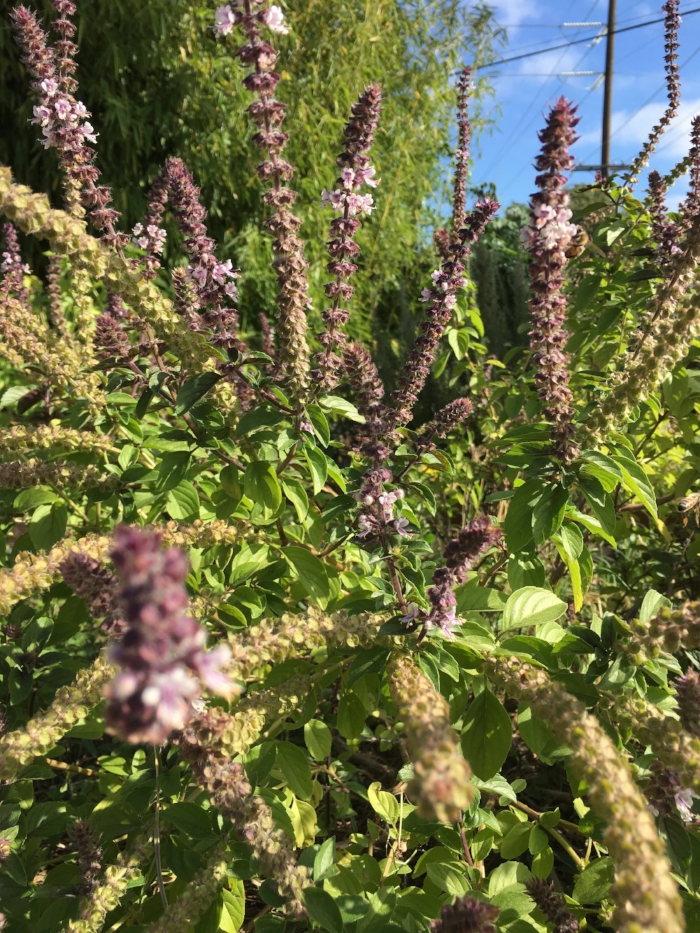Saving basil seed. Plus: To freeze or not to freeze?
Saving Basil Seed
Thai basil going to seed - a treat for bees!
In this Episode 9 outtake, Colleen Dieter talks about saving seed from basil plants. Basils are a bit of a special case because flowering affects the taste of the leaves. When flowers start emerging, the leaves will acquire a more bitter taste. As eaters of basil, we don’t want that; which is why it’s recommended to “pinch” the tops of basil plants (pluck off the flower buds before they open) to prevent them from flowering.
Of course, if you want to save seed from your basil — and why not, it’s so easy to grow from seed — you’ll have to let it flower. So you have a few options: you can either plant two basils, and designate one for seed production, OR stop pinching your basil toward the end of the season (let’s say, around Halloween in Central Texas) so that seed can fully mature on the plant well advance of a freeze. Seed should be saved from stalks that are fully dry and brown and stored in a cool, dry location.
Colleen explains how to harvest the seed and gives us yet another option — let your basil reseed freely and see where it decides to come up on its own next year!
To freeze or not to freeze?
For a few years now, I’ve been putting seeds in the fridge or the freezer indiscriminately without thinking much about it. After all, seed banks do it; why not home gardeners?
The Svalbard Global Seed Vault is a secure seed bank on the very cold Norwegian island of Spitsbergen.
Because Colleen mentioned that she keeps her in the crisper in the fridge, I asked her about freezing seeds. She suggested I talk to Linda Wall, a local expert on the freezer method of seed saving. By coincidence, Linda is teaching a free seed-saving class at the The Natural Gardener at 10am on Saturday, September 29! (Details below.)
According to Linda, there are some pros and cons of freezing seeds: yes, the seeds will last longer if properly frozen, but you need to take extra care to prevent freezer burn, which could ruin your seeds. Here’s what she wrote to me in an email:
“You can absolutely freeze seed IF they are completely and totally dry, and in glass jars or some other non-gas-permeable container. I keep mine in canning jars and wire-bail-lid canisters.
The enemies of seeds are fluctuations in moisture and temperature. Too much of either and the seeds will die. The freezer stops fluctuations in temp, and the glass stops fluctuations in moisture. (That's what freezer burn is - "freeze-drying" from moisture having been pulled out of the food.) So yes, even for the home seed saver, freezing seeds is absolutely the best way to preserve them. That's why the Svalbard vault is where it is! Way the hell up north.
But they gotta' be DRYDRYDRY before you freeze them. To make sure my seeds are dry enough to freeze, I leave them on top of my kitchen cabinets in the a/c for at least a month. Then I pack them up in paper envelopes/bags with source, date collected, and where collected, plus any other info I may need to remember later (true seed? possible cross? rarity? etc.). I put them in the jars with a bit of rice in the bottom to act as a desiccant, then close them up tightly and let them sit on the counter for a couple days just to make sure any humidity is soaked up by the rice. Then into the freezer they go. When taking them out, I let them reach room temp before opening them, especially on days like we've been having this past week, lest the humidity in the air immediately condense on the envelopes and seeds inside. If that happens occasionally it's no biggie, but happening really often isn't really good.”
Thanks, Linda! It turns out that I have been storing seeds incorrectly because I wasn’t putting them in an airtight container, thus exposing them to potential freezer burn. (I’m hoping the possibly-freezer-burned “Earl Grey” larkspur seeds that have been in my freezer will still germinate!)
Check out Linda’s blog, The Redneck Hippie, about gardening, beekeeping, knitting, and sustainably-minded country living in Spicewood, Texas! To learn more about her free seed-saving class, visit The Natural Gardener. Here is the class info from NG’s website:
Saturday, September 29th at 10 am – Linda Wall teaches us all about “Basic Seed-Saving for the Vegetable Gardener.” Gardeners and farmers have been saving seeds and doing their own plant breeding long before we had commercial seed companies. When we correctly save our own home grown vegetable seeds over time, we get varieties that are uniquely well-adapted to our specific site – and our palates! Come and learn how to save your own vegetable seeds to save money, preserve genetic diversity, and ensure you’ll never be without that favorite vegetable variety.


